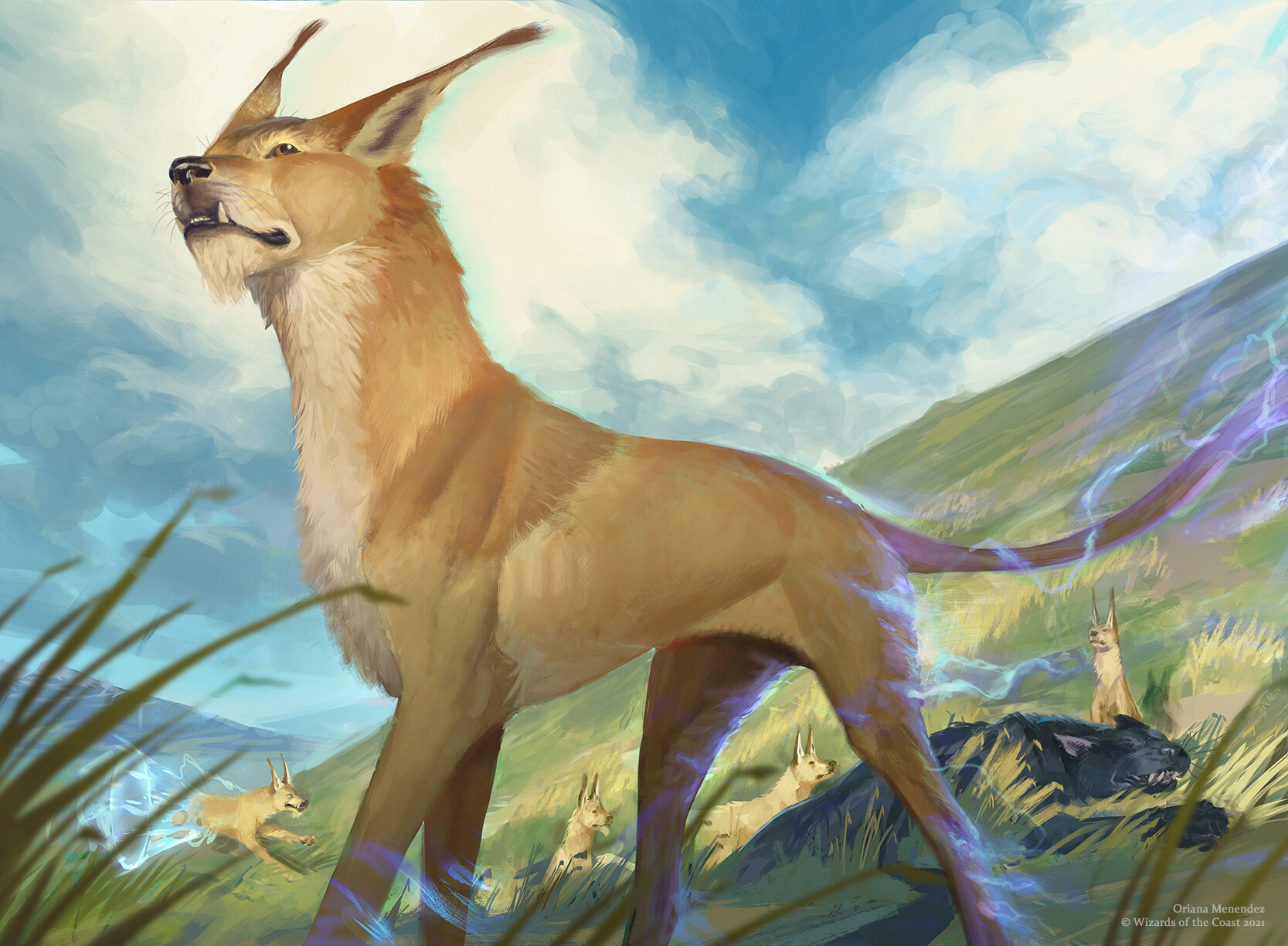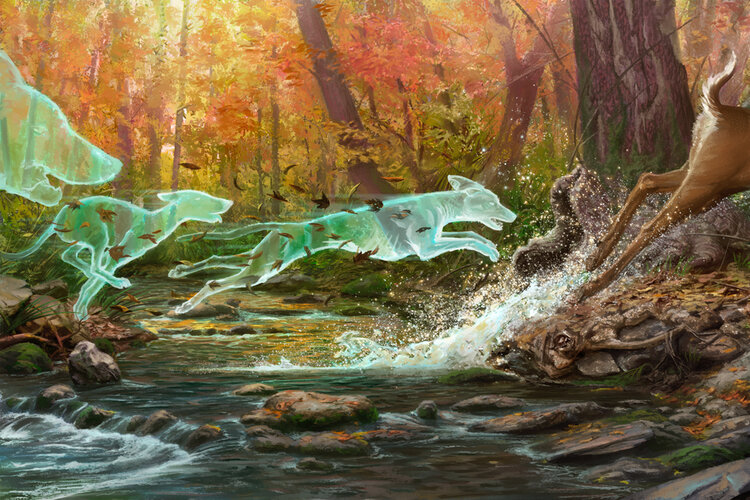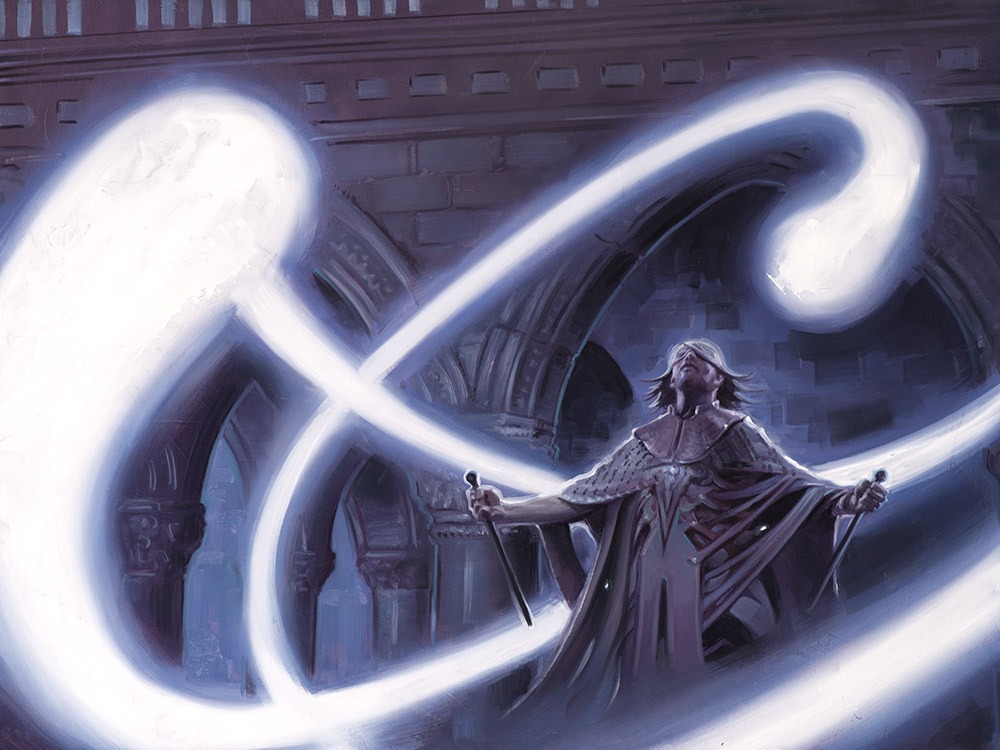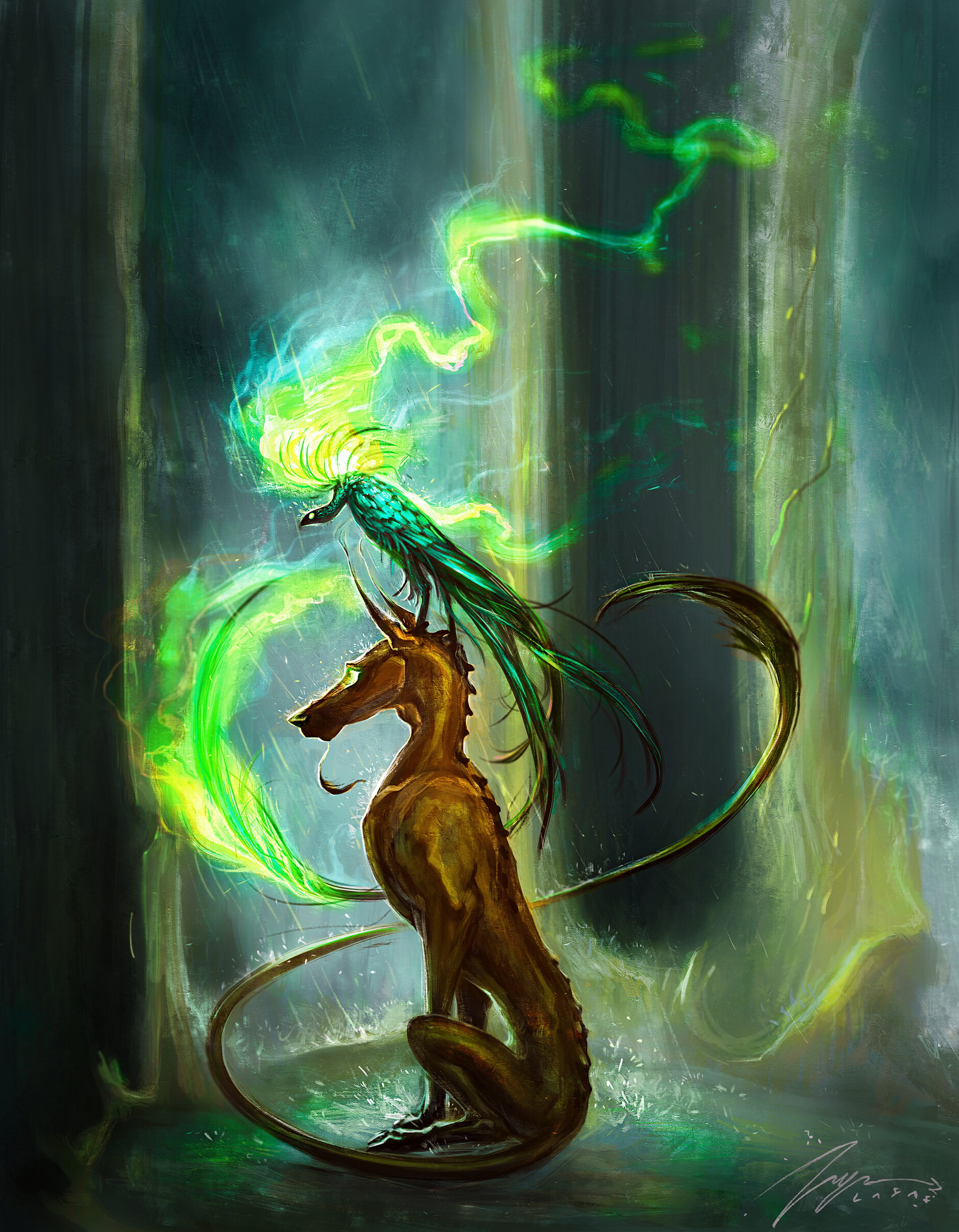
The Blink Dog

Blink Dog Cohorts
A mystic and his companion rested upon a small hill, overlooking the forest where displacer beasts were said to roam.
"I'm as ready as I'm like to be. You?"
The man glanced over to his closest friend-- the canine, in turn, did not remove its gaze from the trees, but nodded slightly.
As they approached the forest gate, the blink dog growled so softly as to be scarcely heard. The young man knew what that meant.
A tentacle as thick as the man's arm smashed into hollow footprints. The man and his companion were gone-- a pair of brief, blue flashes of light were all that remained.
A six-limbed, panther-like creature swiveled around just fast enough to dodge a thrown dagger. The blink dog was more successful, however, biting hard into a hind leg.
The displacer beast howled in pain but kept on the offensive. Its next strike was quick, precise, and painful, knocking the mystic onto his back. At this, the blink dog let go its vicegrip just long enough to yelp. The high pitched noise echoed through the trees. Soon, another blue flash of light appeared, creating a brief glow around their tree-lined arena.
One blue mote of light became two, then four. The displacer beast was all but surrounded when it turned, making a failed swipe at the blink dog before bolting into the darkness again.
The mystic stood with difficulty, then snapped his fingers. A half-dozen spheres of spirit light phased into being around him. These lights floated around him, his companion, and their saviors-- the blink dog's own siblings.
"You have my thanks. Now, let's press the advantage," the man said, looking down at his canine friend. "You taught me your tricks; now's the time I show you mine."
art by Conceptopolis
cover art by Oriana Menendez
Copyright Wizards of the Coast
What is a Cohort?
A creature cohort is a monster straight from the pages of Dungeons and Dragons Fifth Edition that has been redesigned for use as its own race and associated class. A cohort race and class (like the Blink Dog race and Channeler class) are typically meant to be taken together. The Channeler, though, is designed for use with any race or lineage.
A cohort can be used for multiple purposes: as a sidekick (friendly NPC), a recurring villain/rival, or as a player character. You create a cohort much like making a character, following the same rules in the Player's Handbook.
However, cohorts are designed to be built differently depending on how they are used. If a cohort is being used as an NPC sidekick, then the cohort does not get a background at 1st level, nor do they choose a subclass as they advance in their class. Cohorts as sidekicks instead rely on the base class alone for their abilities- which leads to a more streamlined, simpler experience (at a power level a little lower than that of a full-fledged player character).
(Note that, at the time of this writing, there are multiple existing cohorts that are not yet designed around 'subclasses for characters only'. For cohorts prior to the original Angel release (July 2021) it is recommended to use those cohorts as written. Updated versions of those cohorts are planned for future releases.)
Blink Dog Racial Features
Blink dogs are fey that almost resemble 'normal' canines. They are sometimes found in the Material Plane but are said to have come from the Feywild-- a place where the fantastical is the norm, and fey creatures of all types intermingle as they will.
Origins aside, blink dogs only resemble average dogs on the surface level. While most blink dogs do not speak without magical assistance (see the Gem of Primal Insight on page 12), they have an intellect rivaling that of the humanoid species. That, and their ability to teleport via the Ethereal Plane, make blink dogs formidable allies.
Ability Score Increase. One ability score of your choice increases by 2, and one other ability score of your choice increases by 1.
Age. Blink dogs are believed to mature at the same rate as average dogs, becoming adults at about two years, and reaching their full size not long after that. Given that blink dogs are fey and not 'average' animals, though, their lifespans can sometimes approach a full century.


Alignment. Blink dogs are most often raised alongside a pack of their siblings, where they learn to coordinate for hunting and scouting purposes. Their pack instincts serve them well--blink dogs often use their cunning and raw numbers to beat more powerful foes (such as their rivals, displacer beasts). As a whole, blink dogs lean strongly towards cooperating with others for the common good, whether it be other fey or the humanoid species.
Blink dogs can be conditioned much like a typical dog, but they are generally too smart to submit to simple carrot-on-a-stick motivators (like dog treats). That said, blink dogs naturally get along with others, and they certainly won't complain if their efforts are justly rewarded. They are also vigilant creatures, and always seem to have their ears perked up for potential danger.
Size. Blink dogs start out as puppies, though they do tend to be bigger than average dogs of their age. A young blink dog is a Small-sized creature, though it will grow in time.
Speed. Your base movement speed is 30 feet. As you grow, your speed will also increase.
Darkvision. A blink dog's eyes are well adapted to seeing in dim and dark conditions. You can see in dim light within 60 feet of you as if it were bright light, and in darkness as if it were dim light. You can't discern color in darkness, only shades of gray.
Feywild Nature. You count as a fey for the purposes of spells and effects.
Powerful Canines. You have a natural bite attack that deals 1d6 piercing damage. You add your Strength or Dexterity modifier (your choice) to attacks and damage rolls with your bite. Your bite counts as a natural weapon.
You are unable to use other weapons, or any armor (including shields) unless they are specifically crafted for members of your species.
art by G-QM
Keen Hearing and Smell. You have advantage on Wisdom (Perception) checks that rely on hearing or smell.
Teleblink. As an action during your turn, you may teleport yourself and any equipment you are carrying up to 40 feet to an unoccupied space that you can see. Before or after teleporting, you may make one attack with a natural weapon, or with a melee weapon you currently have equipped.
Once you use this ability, you can't use it again until you complete a long rest.
Size Increase. At 7th level, you have grown to the point that you become a Medium-sized creature. Your base speed also becomes 40 feet at that time.
Languages. As a fey with intelligence at the human level, you can understand Common and Sylvan, but cannot speak, read or write most languages by default.
Note that you can, however, speak and understand the language of blink dogs, which expresses complex information through a series of barks and other sounds. Other blink dogs understand this language, and with your DM's permission, another character in the party may learn Blink Dog as an exotic language to be able to understand it fluently. (Note: the "Roleplaying as a Blink Dog" section at the end of this document makes some suggestions to work around the language gap).

New Class: The Channeler
Class Features
As a channeler, you gain the following class features.
Hit Points
- Hit Dice: 1d8 per channeler level
- Hit Points at 1st Level: 8 + your Constitution modifier
- Hit Points at Higher Levels: 1d8 (or 5) plus your Constitution modifier per channeler level after 1st.
Proficiencies
- Armor: Light armor
- Weapons: Simple weapons, scimitars and shortswords
- Tools: None
- Saving Throws: Dexterity, Charisma
- Skills: choose three from Acrobatics, Arcana, Athletics, Deception, Insight, Intimidation, Investigation, Nature, Perception, Persuasion, Sleight of Hand and Stealth
Equipment
You start with the following equipment, in addition to any equipment granted by your background. If you choose to forgo this equipment, you can instead spend 110gp on equipment of your choice:
- (a) shortsword or (b) two daggers
- (a) a shortbow and a quiver of 20 arrows or (b) a shortsword
- (a) an explorer's pack or (b) a priest's pack
- a suit of leather armor
Blink Attack
If you are within 5 feet of another creature, you may use an action during your turn to teleport to another unoccupied space that you can see within 5 feet of that creature. You may then make a single weapon attack as part of this action.
Starting at 3rd level, attacks made with the blink attack feature always qualify for flanking attack damage so long as you do not have disadvantage on the attack roll.
Imbuement
As a bonus action, you reach into the ethereal plane and pull back some of its ghostly essence. You create a pool of d4s equal to your Channeler level. Whenever you or a creature within 60 feet of you that you can see deals damage with a weapon attack, you can spend one die from the pool to increase that damage by an amount equal to the die roll. Damage dealt from the pool is force damage.
This ability lasts 10 minutes. You may use this ability twice, and recover any expended use upon completion of a long rest.
The Channeler
| Level | Proficiency Bonus | Features | Flanking Attack |
|---|---|---|---|
| 1st | +2 | Blink Attack, Imbuement | — |
| 2nd | +2 | Focus, Second Sight | — |
| 3rd | +2 | Flanking Attack, Kennen, One Step Ahead | 1d6 |
| 4th | +2 | Ability Score Improvement | 1d6 |
| 5th | +3 | Focus Recovery, Short Range Teleport | 1d6 |
| 6th | +3 | Ghost Touch, Expertise | 2d6 |
| 7th | +3 | Kennen Feature | 2d6 |
| 8th | +3 | Ability Score Improvement | 2d6 |
| 9th | +4 | Dimension Door, See Beyond | 3d6 |
| 10th | +4 | Kennen Feature | 3d6 |
| 11th | +4 | Improved Imbuement | 3d6 |
| 12th | +4 | Ability Score Improvement | 4d6 |
| 13th | +5 | Between the Planes | 4d6 |
| 14th | +5 | Interposition | 4d6 |
| 15th | +5 | Long Range Teleport | 5d6 |
| 16th | +5 | Ability Score Improvement | 5d6 |
| 17th | +6 | Kennen Feature | 5d6 |
| 18th | +6 | One Thought Ahead | 6d6 |
| 19th | +6 | Ability Score Improvement | 6d6 |
| 20th | +6 | Supreme Imbuement | 6d6 |
.
Focus
At 2nd level, you learn to make more tactical maneuvers using your innate teleportation ability. Teleporting for anything other than a short stint is draining, however, and it takes experience to hone these skills. Your ability to perform a single, extremely precise maneuver is represented by a number of focus points. When you gain your second level in this class, you gain a number of focus points equal to your channeler level. Your maximum number of focus points is always equal to your channeler level.
You can spend these points to activate several features. You start knowing three such features: Blink Dodge, Disorient, and Erratic Charge. You learn more focus features as you gain levels in this class.


art by Tomasz Ryger
When you spend a focus point, it is unavailable until you finish a long rest, at the end of which your focus points reset to a number equal to your channeler level.
Some of your focus features may require your target to make a saving throw to resist the feature’s effects. The saving throw DC is calculated as follows:
Focus Save DC
Blink Dodge
Whenever you are forced to make a Dexterity saving throw against an effect that you can see, you may spend 1 focus point to gain advantage on that saving throw.
Disorient
You may spend 1 focus point when you hit a creature with your blink attack feature. If you do, the next attack roll made against that creature before the end of your next turn has advantage.
Erratic Charge
You may spend 1 focus point and use your bonus action during your turn to activate this ability. If you do so, you do not provoke opportunity attacks this turn.
.
Second Sight
Channellers are said to have senses that stretch between realities, and those who see the world as they do know better than to trust only their eyes. At 2nd level, you have advantage on Wisdom (Perception) checks that rely on hearing or smell. If you have already gained this ability (such as through the blink dog race) then you instead gain proficiency in one skill of your choice.
In addition, you can now pinpoint the location of an invisible or ethereal creature so long as you are within 10 feet of it. You can pinpoint a creature in the Ethereal Plane while you are on the Material Plane, and vice versa.
Flanking Attack
At 3rd level, once per turn, you can deal an extra 1d6 damage to one creature you hit with an attack if you have advantage on the attack roll. The attack must be with your natural weapons, or a weapon with either the light or finesse property. You don’t need advantage on the attack if another enemy of the target is within 5 feet of it, that enemy isn’t incapacitated, and you don’t have disadvantage on the attack roll. The amount of the extra damage increases as you gain levels in this class, as shown in the Flanking Attack column of the Channeler table.


art by Anton Nazarenko
Copyright CD Projekt RED
Kennen
If your cohort is being created as a player character (or if it is meant to have an equivalent power level) then at 3rd level, you choose your subclass-- your kennen, loosely translating to 'what has been made known'. Kennen options are detailed at the end of this class description.
One Step Ahead
You learn to teleport minute distances to conserve your energy, picking up on enemy attack patterns and moving accordingly. Starting at 3rd level, whenever you take damage from a weapon attack, you gain a bonus to your AC equal to your Wisdom modifier until the end of your next turn. You only gain this benefit if you are wearing light or no armor, and are not using a shield.
Focus Recovery
At 5th level, you can spend one minute in uninterrupted meditation to recover your focus points to their maximum. You may also use this ability as part of time spent in a short rest. Once you use this feature, you may not do so again until you complete a long rest.
Short Range Teleport
Starting at 5th level, you may cast the blink and misty step spells without components and without using a spell slot. You may each of these spells this way once, and recover any expended use upon completion of a long rest.
In addition, you may now cast misty step by expending 3 focus points, or the blink spell by expending 5 focus points.
Ghost Touch
Most blink dogs and novice mystics have, at best, the occasional glimpse into the ethereal plane. You, however, learn to bring a small part of that realm with you on your travels, permanently infusing its ghostly energies into your armaments. At 6th level, your natural weapons are considered magical for the purposes of overcoming damage resistance and immunity. This also applies to any weapons you hold in your hands for as long as you wield them.
In addition, you add your Wisdom modifier to the damage roll of any weapon attack that you make with a natural weapon, or any melee or thrown weapon with the light or finesse properties. This bonus damage is force damage.
Expertise
At 6th level, choose two of your skill proficiencies. Your proficiency bonus is doubled for any ability check you make that uses either of the chosen proficiencies.

Dimension Door
At 9th level, You may use the dimension door spell once per long rest without components and without using a spell slot. You may also cast the dimension door spell by expending 7 focus points.
When you cast the dimension door spell using this feature, you may make a single attack as part of the same action, either immediately before or after teleporting.
See Beyond
At 9th level, you are treated as though you are always under the effect of the see invisibility spell, but with a range of 60 feet. You may suppress or resume this ability as a bonus action.
Improved Imbuement
At 11th level, your pool of dice from the imbuement feature become d6s.
Between the Planes
At 13th level, whenever you are under the effects of the blink spell, you appear in the Ethereal Plane on a roll of 8 or higher (as opposed to a roll of 11 or higher).
Interposition
At 14th level, whenever you or a creature within 60 feet that you can see would be reduced to 0 hit points or fewer by a damaging attack or spell, you may use a reaction to teleport to an unoccupied space within 5 feet of that creature (unless the target is yourself). You position yourself between the creature and the triggering attack or spell, taking the damage in their place.
If the target is another creature, that creature gains immunity to the triggering damage. If you are the target, you instead maneuver to reduce incoming damage. In either case, you take half of the damage (rounded up) that the target would have taken from the triggering effect. This halving occurs before damage resistances are accounted for. If the triggering effect forces a saving throw, you roll the save instead of the target, and suffer any consequences of a success or failure in their place.
Once you use this feature, you may not do so again until you complete a long rest.
Long-Range Teleport
Starting at 15th level, you may cast the teleport spell once per long rest without components and without using a spell slot. When you cast the spell in this way, as long as you have a description of the destination at minimum, you always roll as though you are at least "very familiar" with the location (per the Teleport Familiarity chart on page 281 of the Player's Handbook). You still have a 100% chance to wind up on target if you are using a permanent circle or have an associated object per the spell's description.
One Thought Ahead
Starting at 18th level, whenever you fail a saving throw, you gain a bonus on all saves equal to your Wisdom modifier for 1 minute (your Wisdom saving throws add double your Wisdom modifier during this duration).
Supreme Imbuement
You have mastered the art of infusing ethereal energies into attacks, whether they be your own or that of your allies. At 20th level, whenever you would spend die from your imbuement pool, you can spend a number of die up to your proficiency bonus (instead of a maximum of one die per trigger).


Kennen
At 3rd level, blink dogs (and the channelers who share their methods) have learned to perceive the world in a way unique to them. This enhanced understanding of their surroundings--their ken--is captured in one's choice of specialization. You choose one of the kennen options available: the ghost brute, the bloodhound, or the missile adept.
Ghost Brute
The Ethereal Plane is more than a mere pathway to some adventurers. Those who have glimpsed the other side of the planar coin may find themselves studying and even mastering the secrets beyond. The travelers who engage in these studies learn to bridge the gap between the ghostly realm and the Material Plane. As a result, some blink dogs (and their channeler friends) can become easily confused for the ghosts that they mimic.
Ectoplasmic Form
At 3rd level, you may spend your bonus action and 1 focus point to phase partway into the Ethereal Plane until the end of your turn. During this turn, you may move through other creatures as if they were difficult terrain, and you may fit through spaces as if you were a Tiny-sized creature.
If you end your turn inside another creature, or if you end your turn in a space too small for your full size, you take 1d10 force damage and are teleported to the closest unoccupied space. You then take 1d10 force damage for every 5 feet you teleported in this way.
Psychic Spark
Starting at 3rd level, whenever a creature makes a melee attack against you, that creature takes psychic damage equal to your Wisdom modifier. This damage is dealt after the creature makes their attack roll, but before the attack is deemed a success or failure. Multiple creatures may take damage in this way each round, but only once per attacking creature.
Silent Step
Starting at 7th level, creatures have disadvantage on Perception ability checks to notice you using hearing or scent.
Ethereal Jaunt
At 10th level, whenever you teleport as part of a spell effect (such as from the misty step or dimension door spells) you may use a creature as a painful conduit, teleporting through them and disrupting their form.
Choose a creature within range of the casted teleportation spell, then choose an unoccupied space within 5 feet of that creature. You teleport through the creature, violently emerging from their body and ending the spell in the target space next to that creature. The chosen creature must make a saving throw against your focus save DC, taking 8d8 force damage on a failure, or half damage on a successful save. A glowing rift appears in the creature's body as part of this effect, which quickly dissipates.
You may use this ability once, and recover any expended use upon completion of a long rest.
Etherealness
At 17th level, whenever you use your ectoplasmic form feature, you may spend an additional 4 focus points (for a total of 5 points spent) to be able to move through objects as though they were difficult terrain this turn. Whenever you end your turn within an object, you suffer the same effects as though you were inside a creature.
art by Joe Slucher


Bloodhound
Some blink dogs, and the mystics who harness similar powers, choose to train their minds almost to the exclusion of all else. Rather than leaning on their magical techniques, these 'bloodhounds' as they are called move with extreme precision of thought. Some of these warriors fight in a trance-like state. Others have an ebb and flow in their attacks that could be described as beautiful but unyielding. In either case, these combatants can be as deadly as they are precise.
Focused Assault
At 3rd level, whenever you spend focus points, you also add an equal number of d6s to your next flanking attack made within the next minute. At 3rd level, you can add a maximum of 1d6 to your next flanking attack in this way.
At 9th level, you can add up to 2d6 damage to your next flanking attack in this way. At 17th level, you can add up to 3d6 damage.
Posturing
You have learned how to present yourself such that others know you are not to be trifled with. As opposed to personal charisma, you have learned this skill through experience and common sense. Starting at 3rd level, you may add your Wisdom modifier, instead of your Charisma modifier, to Intimidation ability checks that you make.
Unerring Strike
At 7th level, you ignore disadvantage on melee attack rolls that you make. If you gain advantage and disadvantage on the same attack roll, they still cancel each other out as normal.
Ensnare
Starting at 10th level, whenever you critically hit a creature, or hit a creature with an opportunity attack, that creature must make a saving throw against your focus save DC. On a failed save, that creature becomes restrained until the end of their next turn.
Preternatural Flow
At 17th level, whenever you or another creature within 30 feet of you are critically hit, the next attack you make within the next minute becomes a natural 20.
art by Alexey Egorov


Missile Adept
The Ethereal Plane is, to many, poorly understood. Stepping beyond the Ethereal veil is beyond the abilities of most mortals, let alone being able to bring parts of that realm to the Material Plane. Those who learn to summon--and even weaponize--motes of spirit energy gain a tool both powerful and versatile.
Force Dart
Starting at 3rd level, you may use an action during your turn to summon and throw a small projectile of ethereal force. This projectile, which typically manifests as either a dagger of force or a mote of radiant light, deals force damage equal to 1d4 plus your strength or dexterity modifier (your choice) on an attack. The force dart counts as a melee weapon with the light, finesse, and thrown weapon properties. The force dart has a thrown range of 30 feet, and can add flanking attack damage even when thrown (so long as the attack meets the other qualifications for flanking attack, such as having advantage on the attack roll or an ally is within 5 feet of the attacked enemy).
At 11th level, you can summon and throw two force darts (rolling for each attack separately) in a single action. You may choose the same target or different targets for the two force darts, but you may only apply flanking attack damage to one of the attacks on a hit.
Afterimage
At 3rd level, you may cast the mirror image spell once per long rest without components and without using a spell slot. You may also cast the mirror image spell by expending 3 focus points.
When you cast the mirror image spell using this feature, your weapon attacks deal 1 extra point of force damage for each remaining duplicate.
.
art by David Palumbo
Scattershot
At 7th level, whenever you use the imbuement feature, you may choose to immediately expend a number of dice from the imbuement pool up to your proficiency bonus. You create an equal number of glowing orbs that each hit a creature of your choice that you can see within 60 feet. Each orb deals 1d4 force damage to its target. The orbs all strike simultaneously, and you can direct them to hit one creature or several.
At 11th level, each orb instead deals 1d6 force damage to its target.
Shifty
At 10th level, whenever you are hit by a weapon attack, you may use your reaction to teleport up to 20 feet to an unoccupied space that you can see, turning the hit into a miss.
You may use this ability once, and recover any expended use upon completion of a long rest.
Force Barrier
Starting at 17th level, you may cast the wall of force spell once per long rest without components and without using a spell slot.
When the wall of force spell ends, you may cause 2d4+1 force shards to expel from the wall, acting like a magic missile spell with 2d4+1 missiles, targeting one or more creatures within the normal range of that spell as you choose.

Blink Dog Cohorts - Miscellany
Challenge Rating for Blink Dogs
The following challenge ratings are based on the Monster Statistics by Challenge Rating table on page 274 of the Dungeon Master's Guide. Note that the below numbers were calculated without accounting for equipped magic items.
As a point of reference: The average level 20 player character may have a CR around 12-14 depending on the character's build and magic items, and can become higher still when using an optimized build and powerful items.
| Cohort Level | Recommended CR |
|---|---|
| 1 | 1/4 |
| 2 | 1/4 |
| 3 | 1/2 |
| 4 | 1 |
| 5 | 2 |
| 6 | 2 |
| 7 | 3 |
| 8 | 3 |
| 9 | 4 |
| 10 | 4 |
| 11 | 5 |
| 12 | 6 |
| 13 | 6 |
| 14 | 7 |
| 15 | 7 |
| 16 | 8 |
| 17 | 8 |
| 18 | 9 |
| 19 | 10 |
| 20 | 10 |
Roleplaying as a Blink Dog
Blink dogs, despite their fey nature, do possess some of the more familiar traits of 'normal' canines. One example would be a blink dog's knack for cooperating with others; their loyalty is also well documented. A significant difference between blink dogs and the household variety, though, is their human-level intelligence. Note that this alone does not give blink dogs the ability to speak humanoid languages (at least, not without magical help). The Gem of Primal Insight found on the next page is a reprint from the Displacer Beast Cohort- but it may also help with the language gap here.
With this in mind, there is another solution to blink dog communication in a party. Canonically, blink dogs are able to convey complex information with a combination of barks and other sounds. Given that they are as smart as the average person, with reasoning capability to match, it would be far easier to understand what a blink dog is trying to suggest when compared to a typical canine. Having at least one party member who is "versed" in the blink dog's language would also not be a stretch, especially if the blink dog and the other character share a backstory.
A point worth noting- while blink dogs do not read, write or speak 'non-blink dog' languages by default, they do perfectly understand Sylvan as well as any other language gained by their background or other means. For balance purposes, Common is included as one of these languages, by default, in the Blink Dog entry in this document.
A Motley Pack
In a 'typical' party of adventurers, the blink dog could easily fill the role of a highly intelligent, loyal companion. That said, there are sure to be other personalities amongst their kind (much like any other creature). Some blink dogs could be more spry, excited and visibly happy, while others would be more cautious, vigilant, and perhaps even melancholic. Any two blink dogs would have a few quirks unique to them (such as what activities they specifically enjoy), and if given the chance to speak freely, they could easily represent the spectrum of personalities shown by the humanoid species.
Enmity at Birth
The rivalry between blink dogs and displacer beasts is well known, even outside the Feywild. Displacer beasts spent many generations as the pawns of evil fey known as the Unseelie Court. As such, blink dogs often found themselves allying with other creatures (like good or neutral aligned fey, or other intelligent creatures in the Material Plane) to defend their young from displacer beast attacks. With displacer beasts now living as they see fit, they are, on the one hand, no longer forced to fight when they do not wish to. On the other hand, displacer beasts no longer have a proverbial leash keeping them in line, either.
Typically, blink dogs fight in packs when found in the wild-- giving them a numerical edge to counter the displacer beast's more powerful frame. When fighting one-on-one with such a creature, though, blink dogs can still use their superior mobility to fight a more defensive battle. Blink dogs do not prefer to fight alone in any case, and they are smart enough to know not to take on a stronger foe when at a disadvantage.


Gem of Primal Insight
Wondrous item, common (requires attunement by a creature that cannot speak naturally, such as most animals and monstrosities) Attuning to this oval, lavender-colored gem causes it to float just in front of your brow, where it remains until you lose your attunement to it or remove it as an action. You can make the gem meld with you (or unmeld it) as a bonus action, rendering it invisible until it is removed. Its other magical abilities cannot be used while melded, however, requiring another bonus action to make the gem visible again.
While the gem remains visible and active, you gain the ability to magically speak by translating your thoughts into words, which can be heard easily by any creatures within 60 feet. You gain the ability to magically speak and understand Common, plus you gain the ability to speak any other languages that you can understand. You can adopt the voice of any creature that you have heard speak for at least a full minute. However, your voice has a slightly odd ebb and flow to it such that you have disadvantage when trying to mimic the person that you "borrowed" your voice from. Upon completion of a long rest, you can choose to borrow another creature's voice in place of the one you are currently using.
Note that being able to speak does not mean that you have an extensive vocabulary, and depending on your Intelligence score you may not be all that precise with your words, with examples given below:
| Intelligence Score | Speaking Ability |
|---|---|
| 1 | Incapable of true logic, able to speak one's own name and a very limited number of other words, such as "food" or "hurt" |
| 2-3 | Capable of basic tactical thought. Can speak in short sentences, like "Food, we eat?" and "Don't go! Trapped!" |
| 4-5 | Can engage in limited speech, though often still emotes to cover for gaps in vocabulary. "Jakob, you're my friend. I'll get food. Food for us." |
| 6-7 | Can speak reasonably well, though tends to only focus on what's in front of them. Limited imagination. "I like you all, we fight better together." "I hear footsteps behind trees-- an ambush!" |
| 8-9 | Converses about as well as a native speaker, but sometimes stumbles over a word/phrase or uses it incorrectly. "I don't like this... let's nip it in the buttocks." "If it looks like a duck, quacks like a duck, then... well, it'd make for a pretty nice dinner." |
| 10 or more | Vocabulary as nuanced as a native speaker, can hold conversation without difficulty (and with sufficiently high Intelligence, maybe even hold their own better than some) |
.
art by Ferdinand Ladera

Credits
Cover Art by Oriana Menendez (https://www.instagram.com/oroborian/) Page 2 Art by Conceptopolis (https://www.artstation.com/conceptopolis) Page 3 Art by G-QM (https://www.artstation.com/q-m-g) Page 5 Art by Tomasz Ryger (https://www.artstation.com/tomek8401) Page 6 Art by Anton Nazarenko (https://www.artstation.com/tustakari) Page 8 Art by Joe Slucher (https://www.joeslucher.com/) Page 9 Art by Alexey Egorov (https://www.artstation.com/air-66) Page 10 Art by David Palumbo (http://www.dvpalumbo.com/) Page 12 Art by Ferdinand Ladera (https://www.deviantart.com/ferdinandladera) Page 13 Art by by Sofía Laya (https://www.artstation.com/layadraco) Back Cover Art by Xuan Zhang (https://www.artstation.com/scissortz) Watercolor stains by Jared Ondricek (https://watercolors.giantsoup.com/xgte/xgtebottom-left/index.html)


May Your
Sidekick
Move Freely
Creature Cohorts were created by me, Mister_Thr33, and were inspired by Tasha's Cauldron of Everything as well as the 3rd Edition supplement Savage Species
'Creature Cohorts' is unofficial Fan Content permitted under the Fan Content Policy. Not approved/endorsed by Wizards. Portions of the materials used are property of Wizards of the Coast. ©Wizards of the Coast LLC.
Special thanks to the r/unearthedarcana and r/dndhomebrew subreddits for their input and inspiration
No motes of spirit energy were harmed in the making of this document
Thank you all for your support!